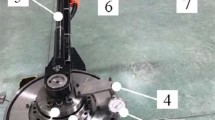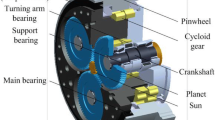Abstract
Analytical modelling for overall torsional stiffness of rotate vector (RV) reducer has been a meaningful research priority owing to its over-constrained and multi-crank actuation structural characteristics. This paper presents an analytical modelling approach for overall torsional stiffness of RV reducer. The approach starts from analysing stiffness topological relations among all components, in order to convert the stiffness modelling of entire machine into the stiffness calculation of several subsystems. Then, time-varying meshing information including contact points, contact pins, contact deformation, and multi-tooth mesh stiffness, are precisely identified with consideration of profile modification and loads. Subsequently, the nonlinear stiffness of turning-arm bearings and support bearings is calculated through the force analysis of crankshafts. On this basis, the overall torsional stiffness model of RV reducer is developed, which concerns various stiffness parameters of high-speed stage and low-speed stage. Furthermore, the sensitivities and influences of stiffness parameters on the overall torsional stiffness of RV reducer are systematically analysed. Finally, the effectiveness and accuracy of the proposed model are validated by the physical prototype test. The outcomes of this paper are beneficial to the stiffness prediction and design of RV reducer according to its performance requirement.














Similar content being viewed by others
References
Pham AD, Ahn HJ (2018) High precision reducers for industrial robots driving 4th industrial revolution: state of arts, analysis, design, performance evaluation and perspective. Int J Precis Eng Manufact Green Technol 5(4):519–533. https://doi.org/10.1007/s40684-018-0058-x
Jiang N, Wang ST, **e XD, Yuan X, Yang AD, Zhang J (2022) A vectorial modification methodology based on an efficient and accurate cycloid tooth profile model. Precis Eng 73:435–456. https://doi.org/10.1016/j.precisioneng.2021.10.008
Jiang DJ, Kim YC, Hong EP, Kim GS (2021) Geometry design and dynamic analysis of a modified cycloid reducer with epitrochoid tooth profile. Mech Mach Theory 164:104399. https://doi.org/10.1016/j.mechmachtheory.2021.104399
Ren ZY, Mao SM, Guo WC, Guo Z (2017) Tooth modification and dynamic performance of the cycloidal drive. Mech Syst Signal Pr 85:857–866. https://doi.org/10.1016/j.ymssp.2016.09.029
Lin WS, Shih YP, Lee JJ (2014) Design of a two-stage cycloidal gear reducer with tooth modifications. Mech Mach Theory 79:184–197. https://doi.org/10.1016/j.mechmachtheory.2014.04.009
Yang YH, Zhou GC, Chang L, Chen G (2021) A modelling approach for kinematic equivalent mechanism and rotational transmission error of RV reducer. Mech Mach Theory 163:104384. https://doi.org/10.1016/j.mechmachtheory.2021.104384
Huang J, Li CY, Zhang Y, Wang YH, Chen BK (2021) Transmission error analysis of cycloidal pinwheel meshing pair based on rolling-sliding contact. J Braz Soc Mech Sci 43(7):355. https://doi.org/10.1007/s40430-021-03074-6
Wu KY, Shih YP, Lee JJ (2020) Kinematic error analysis of the rotor vector gear reducer with machining tolerances. J Braz Soc Mech Sci 42(11):566. https://doi.org/10.1007/s40430-020-02642-6
Sun XX, Han L, Wang J (2019) Design and transmission error analysis of CBR reducer. ASME J Mech Des 141(8):082301. https://doi.org/10.1115/1.4043368
Lin KS, Chan KY, Lee JJ (2018) Kinematic error analysis and tolerance allocation of cycloidal gear reducers. Mech Mach Theory 124:73–91. https://doi.org/10.1016/j.mechmachtheory.2017.12.028
Dion JL, Pawelski Z, Chianca V et al (2020) Theoretical and experimental study for an improved cycloid drive model. ASME J Appl Mech 87(1):011002. https://doi.org/10.1115/1.4044456
Hsieh CF, Fuentes-Aznar A (2019) Performance prediction method of cycloidal speed reducers. J Braz Soc Mech Sci 41(4):186. https://doi.org/10.1007/s40430-019-1690-2
Sensinger JW (2013) Efficiency of high-sensitivity gear trains, such as cycloid drives. ASME J Mech Des 135(7):071006. https://doi.org/10.1115/1.4024370
Gorla C, Davoli P, Rosa F, Longoni C, Chiozzi F, Samarani A (2008) Theoretical and experimental analysis of a cycloidal speed reducer. ASME J Mech Des 130(11):112604. https://doi.org/10.1115/1.2978342
**e YH, Xu LX, Deng YQ (2022) A dynamic approach for evaluating the moment rigidity and rotation precision of a bearing-planetary frame rotor system used in RV reducer. Mech Mach Theory 173:104851. https://doi.org/10.1016/j.mechmachtheory.2022.104851
Yang YH, Chen C, Wang SY (2018) Response sensitivity to design parameters of RV reducer. Chin J Mech Eng 31(1):49. https://doi.org/10.1186/s10033-018-0249-y
Hsieh CF, Jian WS (2016) The effect on dynamics of using various transmission designs for two-stage cycloidal speed reducers. Proc IMechE Part C: J Mech Eng Sci 230(4):665–681. https://doi.org/10.1177/0954406215618984
Hsieh CF (2014) The effect on dynamics of using a new transmission design for eccentric speed reducers. Mech Mach Theory 80:1–16. https://doi.org/10.1016/j.mechmachtheory.2014.04.020
Miao JC, Li CY, Du X, Chen BK (2022) Rotate vector reducer design using resnet-based model and integration of discretized optimization. J Mech Sci Technol 36(4):1889–1902. https://doi.org/10.1007/s12206-022-0326-0
Zhang YM, Li LS, Ji ST (2022) Influence of cycloid-pin gear design parameters on bearing capacity and optimized design. J Braz Soc Mech Sci 44(4):123. https://doi.org/10.1007/s40430-022-03426-w
Yang MD, Zhang DQ, Cheng C, Han X (2021) Reliability-based design optimization for RV reducer with experimental constraint. Struct Multidiscip Optim 63(4):2047–2064. https://doi.org/10.1007/s00158-020-02781-3
Wang YL, Qian QJ, Chen GD, ** SS, Chen Y (2017) Multi-objective optimization design of cycloid pin gear planetary reducer. Adv Mech Eng 9(9):1687814017720053. https://doi.org/10.1177/1687814017720053
Song WL, Yang X, Liu H, Gao XY, Lei YG, Cao JY (2023) A new method for calculating time-varying torsional stiffness of RV reducers with variable loads and tooth modifications. J Field Robot 40(6):1339–1345. https://doi.org/10.1002/rob.22172
Zhang DW, Wang G, Huang T, Liu JY (2001) Dynamic formulation of RV reducer and analysis of structural parameters. Chin J Mech Eng 37(1):69–74 ((in Chinese))
Liu JY, Matsumura S, Chen BK, Houjoh H (2012) Torsional stiffness calculation of double-envelo** cycloid drive. J Adv Mech Des Syst 6(1):2–14. https://doi.org/10.1299/jamdsm.6.2
Li ST (2014) Design and strength analysis methods of the trochoidal gear reducers. Mech Mach Theory 81:140–154. https://doi.org/10.1016/j.mechmachtheory.2014.07.001
Kim KH, Lee CS, Ahn HJ (2010) Torsional rigidity of a cycloid drive considering finite bearing and hertz contact stiffness. In: ASME International Design Engineering Technical Conferences / Computers and Information in Engineering Conference, San Diego, CA, AUG 30-SEP 02.
Kumar N, Kosse V, Oloyede A (2016) A new method to estimate effective elastic torsional compliance of single-stage cycloidal drives. Mech Mach Theory 105:185–198. https://doi.org/10.1016/j.mechmachtheory.2016.06.023
Li X, Li CY, Wang YW, Bk C, Lim TC (2017) Analysis of a cycloid speed reducer considering tooth profile modification and clearance-fit output mechanism. ASME J Mech Des 139(3):033303. https://doi.org/10.1115/1.4035541
Li X, Chen BK, Wang YW, Lim TC (2018) Mesh stiffness calculation of cycloid-pin gear pair with tooth profile modification and eccentricity error. J Cent South Univ 25(7):1717–1731. https://doi.org/10.1007/s11771-018-3863-z
Xu LX (2019) A dynamic model to predict the number of pins to transmit load in a cycloidal reducer with assembling clearance. Proc IMechE Part C: J Mech Eng Sci 233(12):4247–4269. https://doi.org/10.1177/0954406218809732
Xu LX, Chen BK, Li CY (2019) Dynamic modelling and contact analysis of bearing-cycloid-pinwheel transmission mechanisms used in joint rotate vector reducers. Mech Mach Theory 137:432–458. https://doi.org/10.1016/j.mechmachtheory.2019.03.035
Xu LX, Zhong JL, Li Y, Chang L (2023) Design and dynamic transmission error analysis of a new type of cycloidal-pin reducer with a rotatable output-pin mechanism. Mech Mach Theory 181:105218. https://doi.org/10.1016/j.mechmachtheory.2022.105218
Huang YC, Du XS, Zhu CC, Ni GX, Ullah N, Liu H (2019) Mesh stiffness analysis of beveloid gears for the rotating vector transmission. J Mech Sci Technol 33(8):3943–3953. https://doi.org/10.1007/s12206-019-0739-6
Xuan L, **e C, Guan TM, Lei L, Jiang H (2019) Research on dynamic modeling and simulation verification of a new type of FT pin-cycloid transmission. Proc IMechE Part C: J Mech Eng Sci 233(17):6276–6288. https://doi.org/10.1177/0954406219861999
Park JS (2006) Stiffness and error analysis of the cycloid drive. PhD thesis, Seoul National University, South Korea
Yang YH, Zhu LY, Chen ZY, Shen ZG (2015) Analysis of the characteristics of torsional stiffness of RV reducer. J Tian** Univ 48(2):111–118. https://doi.org/10.11784/tdxbz201309096
Ahn HJ, Choi BM, Lee YH, Pham AD (2021) Impact analysis of tolerance and contact friction on a RV reducer using FE method. Int J Precis Eng Manufact 22(7):1285–1292. https://doi.org/10.1007/s12541-021-00537-7
Zhang RH, Zhou JX, Wei Z (2022) Study on transmission error and torsional stiffness of RV reducer under wear. J Mech Sci Technol 36(8):4067–4081. https://doi.org/10.1007/s12206-022-0727-0
Wei B, Wang JX, Zhou GW, Yang RS, Zhou HJ, He T (2016) Mixed lubrication analysis of modified cycloidal gear used in the RV reducer. Proc IMechE Part J: J Eng Tribol 230(2):121–134. https://doi.org/10.1177/1350650115593301
Yang DCH, Blanche JG (1990) Design and application guidelines for cycloid drives with machining tolerances. Mech Mach Theory 25:487–501. https://doi.org/10.1016/0094-114X(90)90064-Q
Hsieh CF (2014) Dynamics analysis of cycloidal speed reducers with pinwheel and nonpinwheel designs. ASME J Mech Des 136(9):091008. https://doi.org/10.1115/1.4027850
Hsieh CF (2015) Traditional versus improved designs for cycloidal speed reducers with a small tooth difference: the effect on dynamics. Mech Mach Theory 86:15–35. https://doi.org/10.1016/j.mechmachtheory.2014.11.013
Lankarani HM, Nikravesh PE (1990) A contact force model with hysteresis dam** for impact analysis of multibody systems. ASME J Mech Des 112:369–376. https://doi.org/10.1115/1.2912617
Dong XY, Deng JY, Chen JP (1996) Force analysis of RV transmission mechanism. J Shanghai Jiaotong Univ 30(5):65–70. https://doi.org/10.16183/j.cnki.jsjtu.1996.05.012
Meng YH, Wu CL, Ling LP (2007) Mathematical modeling of the transmission performance of 2K-H pin cycloid planetary mechanism. Mech Mach Theory 42(7):776–790. https://doi.org/10.1016/j.mechmachtheory.2006.07.003
Harris TA, Kotzalas MN (2006) Rolling Bearing Analysis. Wiley, New York
Chen C (2017) Research on Statics and Dynamics of RV Reducer. PhD thesis, Tian** University, China
Yang YH, Shen ZG, Chen ZY, Zhu LY (2016) Test bench and testing method for torsional stiffness and backlash of reducers. Patent No. CN103776628B, China
Acknowledgements
The authors are thankful to the Editor and Reviewers for their valuable suggestions and comments.
Funding
This research work was supported by the National Natural Science Foundation of China (Grant numbers 52075363 and 51721003).
Author information
Authors and Affiliations
Corresponding author
Ethics declarations
Conflict of interest
The authors declare that there are no competing financial interests or personal relationships that could have appeared to influence the work reported in this paper.
Additional information
Technical Editor: Zilda de Castro Silveira.
Publisher's Note
Springer Nature remains neutral with regard to jurisdictional claims in published maps and institutional affiliations.
Appendices
Appendix 1
1.1 Calculation method of \({\text{ }}k_{{{\text{sp}}}}^{e}\)
The sun gear and planetary gears in the high-speed stage are involute gears, and the mesh stiffness between a single gear pair is calculated by [35]
The total mesh stiffness is expressed as
Thus, the equivalent torsional stiffness of the mesh stiffness between the sun gear and planetary gear is expressed as
where xs and xp represent the modification coefficient of sun gear and planetary gear, respectively; ε denotes the gear contact ratio; rs represents the radius of the sun gear base circle.
1.2 Calculation methods of \({\text{ }}k_{{{\text{s}}}}^{e}\) and \({\text{ }}k_{{{\text{a}}}}^{e}\)
The input shaft and crankshaft are divided into multiple shaft segments, so their torsional stiffness can be calculated by
where ns and na represent the numbers of the shaft segments of the input shaft and crankshaft, respectively.
The equivalent torsional stiffness of the both can be further expressed as
1.3 Calculation method of \({\text{ }}k_{{{\text{b}}}}^{e}\)
Referring to Fig. 5, the bending deformation of the crankshaft is expressed as
where δq and δH represent the bending deformation along the rotation direction caused by Fq and FH, respectively.
Then the equivalent torsional stiffness of the bending stiffness of the crankshaft can be expressed as
Appendix 2
See Table
4.
Rights and permissions
Springer Nature or its licensor (e.g. a society or other partner) holds exclusive rights to this article under a publishing agreement with the author(s) or other rightsholder(s); author self-archiving of the accepted manuscript version of this article is solely governed by the terms of such publishing agreement and applicable law.
About this article
Cite this article
Zhou, G., Yang, Y., Chang, L. et al. An analytical modelling approach for overall torsional stiffness of rotate vector reducer. J Braz. Soc. Mech. Sci. Eng. 46, 156 (2024). https://doi.org/10.1007/s40430-024-04719-y
Received:
Accepted:
Published:
DOI: https://doi.org/10.1007/s40430-024-04719-y




